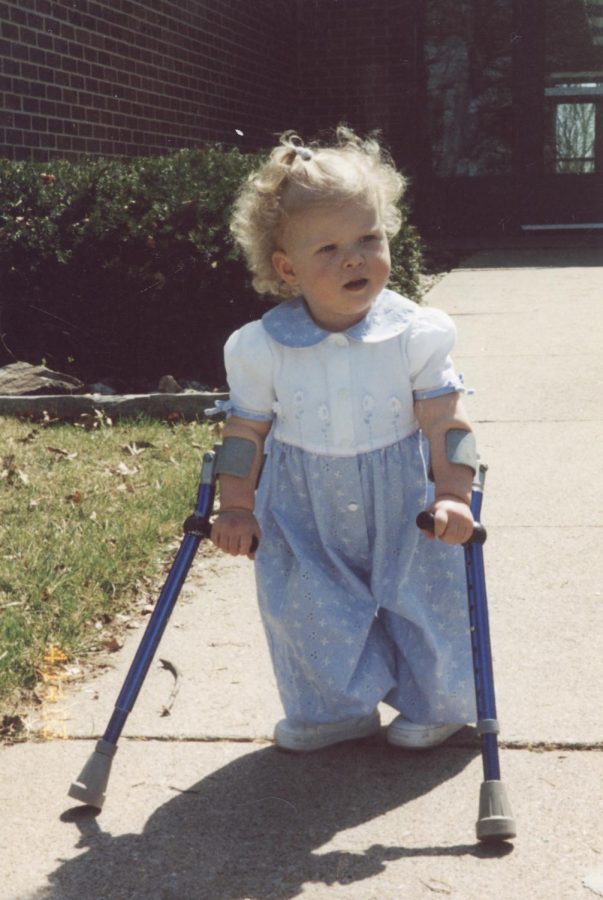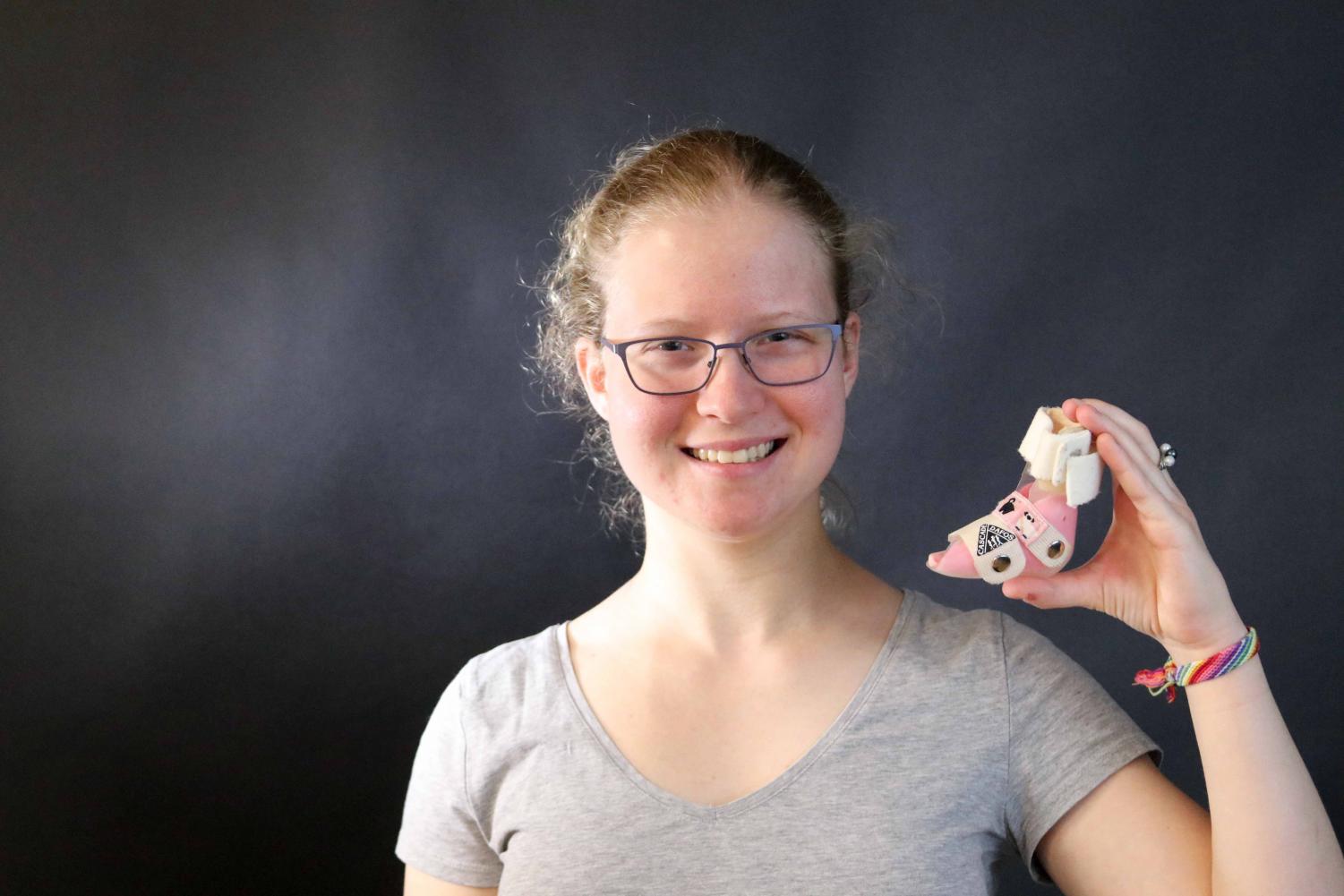Your donation will support the student journalists of Iowa City High School. For 2023, we are trying to update our video and photo studio, purchase new cameras and attend journalism conferences.
A Piece of Me
Megan Bywater '19 on what growing up with spina bifida has been like.
October 25, 2018
When Megan Bywater ‘19 was one and a half, she achieved mobility that no one expected. With the help of braces and crutches, she walked for the first time. Since then, she has been exceeding expectations. She participates in choir and band; she loves to play games and spend time with family and friends. Many things have shaped Megan, but only one of those pieces is her spina bifida.
The Mayo Clinic website states that spina bifida occurs when there are problems with the development of the spine and spinal cord. According to the Spina Bifida Association website, there are four different types of spina bifida, including occult spinal dysraphism, spina bifida occulta, meningocele, and myelomeningocele; also called spina bifida cystica. Spina bifida is first developed during pregnancy. Before birth, it can be found through ultrasound, the alpha-fetoprotein (AFP screening test), or a test where fluid is taken from the womb. Pregnant women take folic acid to prevent spina bifida. There are treatments in the form of surgeries, but as of right now, there is no cure.
When Angie Bywater was in her second trimester of being pregnant, she received unexpected news. Through an ultrasound, the doctors had found that her baby had spina bifida.
“It was scary, but we just tried to learn as much as we could. Everybody was asking lots of questions and wanted to know,” Angie said. “I had an aunt who called and just said, ‘We don’t need to ask any questions. We just want you to know that we will love your baby.’”
As Angie and her husband, David, continued to do research and prepare for their baby, Angie read “Living with Spina Bifida, a Guide for Families and Professionals” by Adrian Sandler, M.D. Through reading the book Angie found advice and this takeaway:
“Right now, while you’re still pregnant, [this diagnosis] is the only thing you know about your baby,” Angie said. “We didn’t even know her sex at that point, if she was a boy or a girl, we just knew she had spina bifida but that’s just one little thing about your baby. There will be so many more interesting things about this child than the fact that he or she has spina bifida, that’s just one piece.”
And this was true; spina bifida is only one piece of Megan Bywater. She has always had braces on her legs but has used different tools to help her walk. She had a stander when she was one. Then she walked for the first time at the age of one and a half with the help of her braces and walker. From there she progressed to crutches, and by the age of two and a half had dropped the crutches and was walking on her own.
“It was the physical therapist who said Megan was ready for a walker,” Angie said. “So we talked to the orthopedic surgeon that we see. And he said, ‘Well, she’s not really ready, I’ll write the prescription but don’t be disappointed because it’s going to take a little more time.’ The physical therapist borrowed a walker from somebody and she brought it to our house. Megan walked across the room that night with the walker.”

From there, Megan needed practice with walking. She and her mom would go to the Sycamore mall and travel throughout the halls.
“Mom used to take me to the mall and make me walk around and I hated it,” Megan said.
While Angie recognized that this was hard for Megan she knew they needed to practice.
“We had to practice,” Angie said. “She would say, ‘Carry me. Carry me.’ I would have to say, ‘No, come a little farther.’”
Megan has faced adversity because of her spina bifida. When she was four she refused to wear shorts because she didn’t want others to see her braces. As a kindergartner Megan was asked a lot why she “walked like that,” or “why she wore braces,” and sometimes she would see kids imitate how she walked.
“That’s when Megan was realizing that she had something different because she had her braces. Kids don’t have filters,” Angie said. “Kids would just ask questions and that would make her feel bad. We always said, ‘Answer the questions; it’s better if people feel welcome to ask than if they’re whispering behind your back.’”
Sometimes even people with good intentions still made Megan feel singled out. Megan partook in a princess dance class when she was little. It included a performance at the end of the session.
“Megan would do the exact same thing that everybody else would but when she did it, when everybody went across the stage one at a time, the other moms would always clap more for Megan,” Angie said. “It totally made her self conscious.”
Megan has held her head high and continued to explore her interests. In fifth grade she went to Girl Scout camp.
“When she went to a Girl Scout camp, one of the days I wasn’t there and the other leader said, ‘We went on this hike and all of the girls were complaining that the hike was too long except Megan,’” Angie said.
Megan continues to beat the odds by dabbling in skiing. Her family usually went skiing at Sundown while she read or shopped with her mom. One year though, they decided to take a trip out to the National Sports Center for the Disabled in Denver, Colorado.
“The director of the whole program was talking to [Megan] and she was stone-faced and normally Megan’s very perky. He said, ‘Okay, I need to talk to your mom about what size boots you need to wear,’” Angie said. “He took me in the backroom and said, ‘What’s going on? Am I doing something wrong?’ I said, ‘Honestly, I’m not sure she knows she’s disabled.’ I mean, she did, but it just wasn’t a word that we used.”
Megan was familiar with the word, but not in relation to her.
“I don’t like [the word] ‘disabled’ at all because I am able to do stuff, I just have some limitations. I feel like ‘disabled’ is really restrictive. It’s definitely not a word I like to hear. Especially because I don’t walk around in my life saying I have a disability,” Megan said. “That’s not comfortable for me.”
Megan warmed up to the idea behind the program after the first day. The NSCD includes many different options for adaptive skiing. Megan found that the best option for her was a bike ski. A bike ski looks like a bike but instead of pedals and wheels it has skis.
“[With skiing there was] no care in the world. [I was] going down the mountain like a normal person. In some ways I felt cooler going down the mountain,” Megan said. “My instructors played Disney [music] so I sang. Nobody else had this experience.”
Megan has gone through a lot with her spina bifida. The effects of it are different for everyone.
Its placement on the spine determines how much mobility anyone has. Many people with spina bifida require a wheelchair. For a long time, Megan didn’t know others with spina bifida. That all changed when, before her sophomore year, she went to the national spina bifida conference in Minneapolis. She was placed with other kids with spina bifida in the same age group.
“It’s difficult when you go to a school and nobody knows what you’re going through and then you go to this conference where everyone is aware and there are no secrets,” Megan said. “You get to talk freely about stuff you’d never talk about with your friends at school.”
Though Megan has struggled with finding people who understand what she is going through, she has discovered friends.
“Maggie Cremers [‘19], great person, we’ve known each other for a really long time since our dads work together,” Megan said. “From day one she got me through so many situations and with the most awkward situations she would say, ‘Whatever! Let’s go through this together.’”
While Cremers and Megan have always been close, their shared activities have strengthened their friendship.
“We’ve always been very close even though a lot of our interests are very different,” Cremers said. “I was really into softball and sports and obviously Megan has trouble identifying with that part of me, so we have to find more activities we have in common, like music and stuff like that. Our friendship has always gone back and forth from what we do together, but we’ve always been really tight.”
Just as Cremers has been alongside Megan for a long time, so have her doctors. She’s had to switch some of her doctors because they’ve retired. She’s been with them since birth. Megan reflected on making that change:
“[Changing doctors is] a little nerve-wracking because I don’t know what I’m getting into,” Megan said. “I know they know everything but it’s still a change and I do not like change. You have to tell [the doctors] all those uncomfortable things about yourself again.”
Megan and her family have found that even doctors can misjudge a situation. Originally, Megan’s parents had been told that by her teen years she would most likely be in a wheelchair.
“We fully expected that when Megan got into her teen years she would be in a wheelchair so this is a surprise,” Angie said. “Her doctors tell her all the time that this is awesome. She’s totally beat the odds.”


Sue Brenneman • Oct 29, 2018 at 11:37 pm
Hi Megan,
I remember the first time you came to church with your walker and your tiny crutches too. You have always been an amazing inspiration for myself and all who know you. Life hasn’t been easy for you but you smile and your eyes light up and life is just life and you Megan have mastered it with the love of God, your family and friends. And, I love teal.
Judy Rehak • Oct 27, 2018 at 7:38 am
How wonderful! Strong girl and strong family!
Aunt Mary • Oct 26, 2018 at 10:10 pm
Thank you Megan for sharing your story – honestly and openly.
It is a joy to know you are a part of our family. It’s an honor to be part of yours. Love you!
Sheliah Roy • Oct 26, 2018 at 2:42 pm
Hi,
I’m Sheliah Roy with the Spina Bifida Association. We’d like to share Megan’s story on the new website we’re launching.
We will give the newspaper credit. If it is ok with you, will you send the photos as separate images?
Thank you for your consideration.
Sincerely,
Sheliah Roy
Director, Marketing and Communications
Spina Bifida Association
jrogers • Nov 7, 2018 at 3:08 pm
Yes! That would be great to share the story to a wider audience and Zoe would love the byline or a link back to TheLittleHawk.com
Marcy Hamilton • Oct 26, 2018 at 8:57 am
What a positive and uplifting story! Lot’s of courage here in this young lady! Something we can all aspire to !